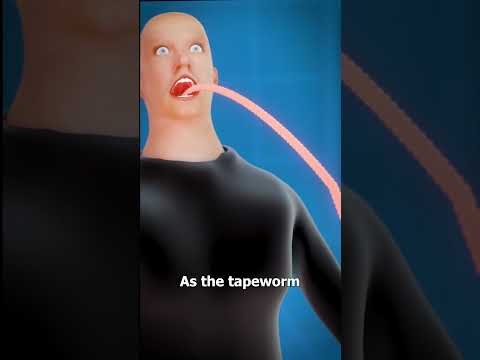Tape worms aren’t just creepy crawlies that live in your intestines. They’re fascinating yet alarming creatures that come with a bundle of shocking facts that most people never learn. These parasitic flatworms can lead to serious health issues in both humans and pets, and understanding them is crucial for maintaining our health and fitness. Let’s jump right in and uncover this astonishing world of tape worms with insights that might just leave you stunned!

Understanding Tape Worms: Unveiling Shocking Secrets
Tape worms thrive in the shadows of popular knowledge, but it’s time to shine a light on them. These parasites often hide in plain sight, leading many to misconstrue the risks associated with them. The truth is, tapeworm infections can kick start health issues you’d least expect. Let’s break it down and expose some secrets about these parasitic worms that could change how you see your pet or your meal choices!

7 Shocking Facts About Tape Worms You Didn’t Know
Tape worms are surprisingly widespread around the globe, affecting more individuals than you might think. The CDC reports around 1,000 new cases of intestinal tapeworm infections yearly in the U.S. alone. Common species like Taenia solium and Diphyllobothrium latum spread quietly under the radar, highlighting a significant knowledge gap. Yep, millions are affected, and they might not even know it!
Pet owners, take note! You might be startled to realize that flea dirt can be a direct link to tapeworm infections. Flea dirt—those tiny black specks you see on your pet—can contain tapeworm eggs. When your furry friend grooms themselves and accidentally ingests fleas, bingo! They may become hosts to these creepy crawlers. Brands like Frontline and Advantage can help shield your pets from fleas, which, in turn, keeps those pesky tape worms at bay.
Think losing weight is always great? Well, not when it’s caused by a parasite! Tape worms can mess with your appetite in odd ways. They absorb the nutrients you need right from your food, leading to sudden weight loss and increased hunger. Research published in the Journal of Infectious Diseases shows that infected individuals often find themselves craving food more than usual. This can lead to further complications and nutrition issues—what a mess!
Many people with tape worms don’t realize they’re infected until it’s too late! Symptoms are often subtle. While some experience nausea or abdominal pain, others might not feel anything for years. That’s why increased awareness around routine screenings is vital, especially for those in areas where tape worms are common. Don’t let ignorance keep you in the dark; stay proactive about your health!
There’s a reason culinary professionals stress the importance of cooking meat thoroughly. Consuming undercooked or raw meat, particularly pork and fish, can leave you vulnerable to tapeworm infections. Just ask the Massachusetts woman who contracted a severe Diphyllobothrium infection after indulging in sushi. Thoroughly cooking your meals not only makes them taste better but also keeps you protected from parasites—now that’s food for thought!
Tapeworms aren’t just passive passengers; they’re evolving. Continuous exposure to medical treatments can lead to drug resistance over time, making eradication tricky. To tackle this, health experts are advocating for integrated parasite management that combines various treatment strategies. It’s like adapting your workout plan for gains; the same logic applies here—stay flexible in your approach!
The fight against tape worms isn’t just a personal battle; it’s a community concern. Poor sanitation and inadequate water treatment systems contribute significantly to their spread. According to the World Health Organization (WHO), better sanitation practices are linked to fewer tapeworm cases. So, let’s push for better public health initiatives and advocate for communities needing sanitation improvements!

Protecting Yourself and Your Pets from Tape Worms
If you want to protect yourself and your pets from tape worms, regular vet visits and personal hygiene are essential. Keep an eye out for possible signs of infection in your pets, such as unexpected weight loss or segments of tapeworms in their poop. On a broader scale, supporting community health initiatives focused on sanitation can significantly lower the risk of tapeworm infestations. It’s a collective responsibility to live in a cleaner environment!

Rethinking Our Approach to Tape Worms
The conversation about tape worms is long overdue for a makeover. It’s all about shifting the narrative from fear to understanding. By learning about their life cycles, their connection with flea dirt, and their overall health impacts, we can develop better strategies for prevention. Moreover, delving into ecological and socioeconomic factors that influence tape worm prevalence will help us create effective public health initiatives. Educating ourselves isn’t just helpful; it’s essential in the fight against these fascinating yet alarming parasites.
Understanding tape worms opens the door to a host of health revelations. It’s clear that knowledge is power, and it’s time to take charge of your health and the health of your beloved pets. By remaining vigilant and educated, we can tackle these challenges head-on. So, roll up your sleeves, be proactive in your health journey, and embrace a parasite-free life while working towards those ripped six packs! Together we push for fitness and wellness without the lurking danger of parasites.

Tape Worms: Secrets That Will Shock You Today
Bizarre Beginnings of Tape Worms
Surprisingly, tape worms could be a lot more common than folks might think! These parasitic creatures can grow to over 30 feet long, living in various animals, like pets and livestock. Just imagine finding one of those in your pet dog! If you want to dive deeper into shocking animal companions, check out the tale of Ruth Barbie, who’s taken quite the journey in caring for her unique pets. Interestingly enough, tape worms can affect human health as well; it’s an unsettling thought that could lead to some clay colored stool if a person is infected. For more about bodily signs and signals, you can read about clay colored stool.
The Hidden Life of Tape Worms
Tape worms have an intriguing way of survival. They attach themselves to the intestinal walls of hosts and feast on their nutrient intake. To put it simply, they’re like uninvited guests who stick around for the buffet! Folks might be shocked to learn that symptoms often don’t surface until the parasite is well-established. There are even instances of folks mistaking their weight drop for something simpler. Those curious about relaxation techniques might want to explore weighted Blankets — perfect for relieving stress in case tape worms are on your mind!
Cultural Impact and Quirky Facts
Did you know that some cultures have historically used tape worms as a means to lose weight? It’s a risky practice that certainly leaves a lot to be desired! Speaking of peculiar stories, if you enjoy outrageous surprises, check out the latest about UFO sightings over on Reddit Ufo. Oh, and get a load of this: while some may associate comfort with Sudocrem for skin ailments, it’s essential to tackle the underlying problems instead of masking them—kinda like how you shouldn’t ignore tape worm symptoms. As they say, knowledge is power! And for those interested in additional surprising celebrity facts, Debbie Rowe has a few interesting stories up her sleeve too!
To wrap things up, understanding tape worms reveals the importance of being health-savvy and mindful about what goes into our bodies. Keep an eye out for these secretive parasites, as ignorance might just be your worst enemy when it comes to staying well.



























